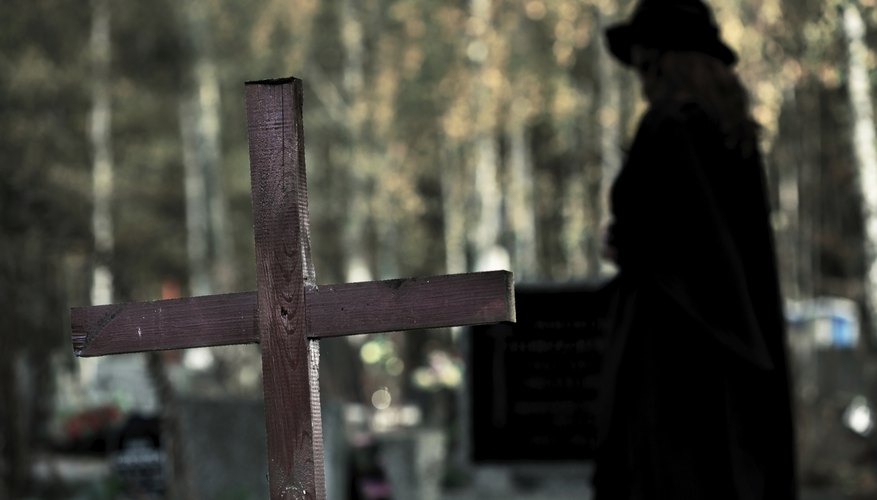Funeral veils are a traditional symbol of respect for the deceased. Women closest to the deceased in his lifetime, including sisters, mothers, daughters, widows and fiancées, wear them. Though it is not culturally required that women continue to wear the veils today, they are frequently favoured because their material provides the mourning woman with a protective barrier from the outside world. Funeral veils also show others that the woman is in high mourning and at a particularly emotional point in her life. The making of short and long veils is quite different and will depend on your personal tastes.
Long mourning veil
Measure yourself from your shoulder blades to the bottom of your sternum, passing over the top of your head. This measurement is your veil's length. Next, measure from bicep to bicep, passing over the top of your head once again, to discern your veil's width. Long mourning veils, or mantillas, provide the mourner with the most optional coverage. However, the long face covering may also be lifted back if she desires.
Cut fine black netting into an oval, superimposing your length and width measurements onto the fabric. Pin black lace around the outer edge of your netting and sew in place. Either use a wide stitch on your sewing machine or stitch by hand.
Place the veil over your head with the inside facing out and adjust it to lay as you want. At the crown of your head, place the bridge of the comb, keeping the teeth facing up and pointing behind you. Hold it in place and take the veil from your head.
- Measure yourself from your shoulder blades to the bottom of your sternum, passing over the top of your head.
- At the crown of your head, place the bridge of the comb, keeping the teeth facing up and pointing behind you.
Stitch the comb to the veil at that point, wrapping your thread around the comb's teeth. Keep your stitches on the outside of the veil neat and close to the comb's bridge. Knot the thread on the underside of the comb and clip.
Eye-length veil
Cut your French or Russian netting into an 45 by 45 cm (18 by 18 inch) square, leaving the finished edge untouched. Cut 7.5 cm (3 inches) from the two corners of the unfinished top edge so the square becomes a hexagon.
Knot a long piece of thread on the net where the finished and unfinished edges meet. Sew a running stitch between the wide nets of the veil across all the unfinished edges. As the finished edge is going to be the one on display, it does not need any stitching.
Pull the running stitch taut so the netting gathers at the top. Pin the gathers at a 7.5 cm (3 inch) width and sew in place.
Sew the gathered edge to the underside of the comb, weaving your stitches between the comb's teeth. Knot the thread on the underside and push the comb forward into your hairline, keeping the bridge of the comb at the crown of your head. Fold the netting down over your face.
- Cut your French or Russian netting into an 45 by 45 cm (18 by 18 inch) square, leaving the finished edge untouched.
- Sew the gathered edge to the underside of the comb, weaving your stitches between the comb's teeth.
